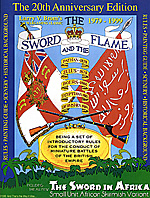
Somewhere in the twisting valleys of Afghanistan, the local Khan began to incite his Pathan countrymen into a state of revolt. Determined to nip this potential problem in the bud, the local British commander decided to mount an expedition to the Khan's village--and burn it. "Only thing the natives understand," huffed the Colonel.
Rounding up some Indian regiments to augment his British regulars, the force headed for the village. Using a wide-spread approach and numerous scouts, the British found the Pathans, shot them to pieces, charged into what was left, and routed them away. Sadly, the Khan also made his escape, and if Indian casualties were moderate, British losses were light. But the flames that day burned all the brighter for it.
Replay
The above is a synopsis of a three-hour miniatures game using the new 20th Anniversary Edition of The Sword and the Flame. Four British and five Pathan players, supervised by one umpire, battled across a 6x16-foot table replete with hills and two valleys, a fort at one end and a village at the other.
The British force consisted of two infantry units per player plus one cavalry unit, a pack train, signalling heliograph group, and three cannons. The Pathans also had two infantry units per player plus one cavalry unit, two cannons, and a fanatical had-to-hand unit of Ghazi. Points wise, British (947) outnumbered the Pathans (758).
The Pathans began hidden and could move hidden until spotted by scouts, units, or the signalling group. Due to the terrain and number of units and that the forces would march across the length (16 feet) of the table and fight across the width (6 feet) of the table, the British could deploy more than enough scouts.
Any Pathan surprise would come from the cards--remember, card draws determine the order of movement and firing. As can be expected, the scouts suffered heavily but all the Pathans were found. Visibility is four inches for concealed units, and scouts can be up to 24 inches from a parent unit. No ambushes in this game.
The best hope for a Pathan win lay where the valley splits into two valleys. Here, Pathan units could shelter from British artillery and rifle fire--or at least only suck up one round of lead before coming to grips with the British forces. The tactic worked since the British fire felled only a few Pathans, and the initial hand-to-hand melee worked in the Pathan favor. However, the next turn, massed fire from remaining British units pulverized the Pathans in the open. End of Pathan counterattack.
The fanatical Ghazis charged round the bend and forced a British unit back, but again, firepower soon thwarted the initial success. So the game continued, Pathans increasingly obligated to charge the relentless British tide, with local successes and tremendous losses until the morale broke. Outgunned and forced into narrow lanes of attack, the Pathans crumbled and fled.
Recap
True to history, sword and spear-armed natives (well, half had rifles, half had only swords) charging British lines will die in droves. The British expedition was never in serious danger.
Card draws in large multiplayer games tend to set players adrift while waiting for "their" draw. And when you draw for movement and draw again for fire, it can be long indeed. It's a drawback for all rules that use such a mechanic. On the bright side, non-simultaneous moves and fires can add suspense.
The British played smart--excellent scouting foiled any Pathan surprises. British firepower slaughtered the natives. British morale held at all the right times. British artillery was especially well deployed and redeployed. Even the signalling crew did their spotting job. The Pathans did as best as they could, but without huge numbers, the tabletop result mimicked historical results--a British victory.
Game Review: The Sword and the Flame 20th Anniversary Edition
Back to MWAN #103 Table of Contents
Back to MWAN List of Issues
Back to MagWeb Magazine List
© Copyright 2000 Hal Thinglum
This article appears in MagWeb (Magazine Web) on the Internet World Wide Web.
Other military history articles and gaming articles are available at http://www.magweb.com